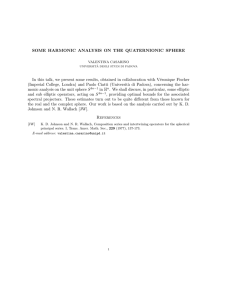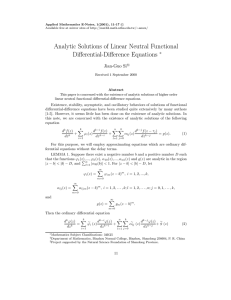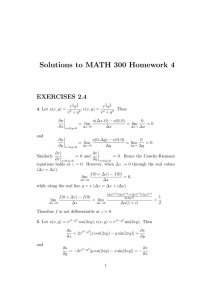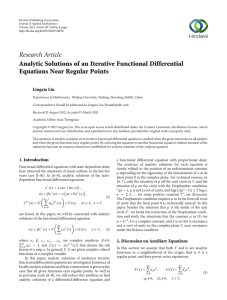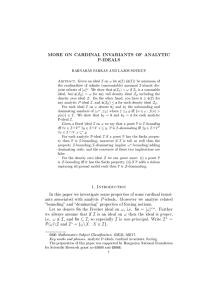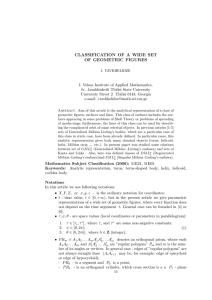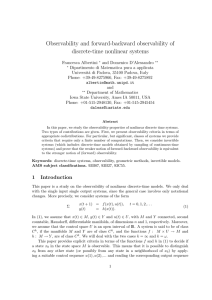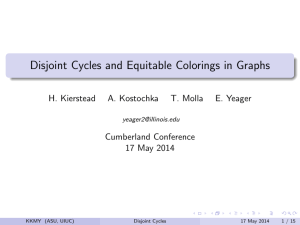Elliptic Curves
advertisement
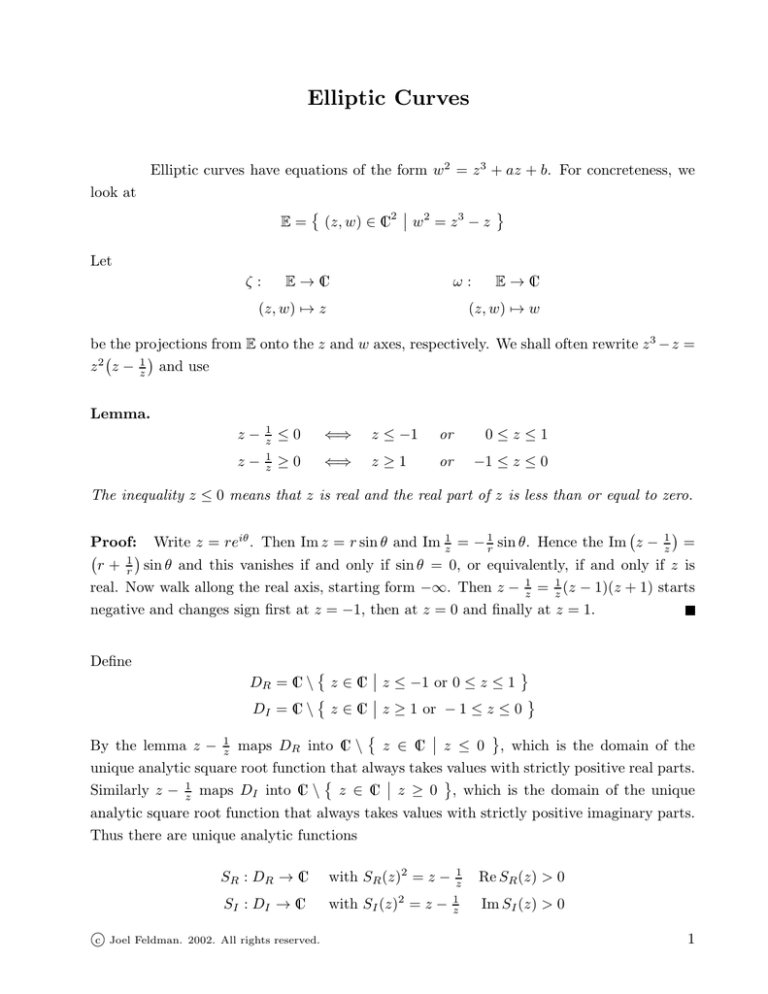
Elliptic Curves
Elliptic curves have equations of the form w2 = z 3 + az + b. For concreteness, we
look at
E=
(z, w) ∈ C2 w2 = z 3 − z
Let
ζ:
E→C
ω:
(z, w) 7→ z
E→C
(z, w) 7→ w
be the projections from E onto the z and w axes, respectively. We shall often rewrite z 3 − z =
z 2 z − z1 and use
Lemma.
z−
z−
1
z
1
z
≤0
⇐⇒
z ≤ −1
or
0≤z≤1
≥0
⇐⇒
z≥1
or
−1 ≤ z ≤ 0
The inequality z ≤ 0 means that z is real and the real part of z is less than or equal to zero.
Proof: Write z = reiθ . Then Im z = r sin θ and Im z1 = − 1r sin θ. Hence the Im z − z1 =
r + r1 sin θ and this vanishes if and only if sin θ = 0, or equivalently, if and only if z is
real. Now walk allong the real axis, starting form −∞. Then z − z1 = z1 (z − 1)(z + 1) starts
negative and changes sign first at z = −1, then at z = 0 and finally at z = 1.
Define
z ∈ C z ≤ −1 or 0 ≤ z ≤ 1
DI = C \ z ∈ C z ≥ 1 or − 1 ≤ z ≤ 0
DR = C \
By the lemma z −
1
z
maps DR into C \
z ∈ C z ≤ 0 , which is the domain of the
unique analytic square root function that always takes values with strictly positive real parts.
Similarly z − z1 maps DI into C \ z ∈ C z ≥ 0 , which is the domain of the unique
analytic square root function that always takes values with strictly positive imaginary parts.
Thus there are unique analytic functions
SR : DR → C
SI : DI → C
c Joel Feldman.
2002. All rights reserved.
with SR (z)2 = z −
with SI (z)2 = z −
1
z
Re SR (z) > 0
1
z
Im SI (z) > 0
1
Define
(z, w) ∈ C2 2 E−
=
(z,
w)
∈
C
R
(z, w) ∈ C2 E+
I =
(z, w) ∈ C2 E−
I =
E+
R =
z ∈ DR , w = zSR (z)
z ∈ DR , w = −zSR (z)
z ∈ DI , w = zSI (z)
z ∈ DI , w = −zSI (z)
−
Then {E+
R , ζ} and {ER , ζ} are disjoint patches that cover all (z, w)’s except those with z ≤ −1
−
or 0 ≤ z ≤ 1. Similarly, {E+
I , ζ} and {EI , ζ} are disjoint patches that cover all (z, w)’s except
those with z ≥ 1 or −1 ≤ z ≤ 0. So far all of E is covered except for (0, 0), (1, 0) and (−1, 0).
So far, compatibility is trivial, since ζ ◦ ζ −1 is the identity map.
Let f (z) = z 3 − z, z0 = 0, z1 = 1 and z2 = 2. Then for i = 0, 1, 2, f (zi ) = 0 and
f ′ (zi ) = 3zi2 − 1 6= 0. Consequently, there is a small neighbourhood Bi of zi such that f (z)
is 1–1 on Bi with analytic inverse, fi−1 (w) on f (Bi ). Note that 0 ∈ f (Bi ) and fi−1 (0) = zi .
Define
Ei = (z, w) ∈ C2 w2 ∈ f (Bi ), z = f −1 (w2 )
i
Note that (zi , 0) ∈ Ei and that Ei ⊂ E since, if (z, w) ∈ Ei , f (z) = f fi−1 (w2 ) = w2 . Then
the four previously defined patches, together with {Ei , ω}, i = 0, 1, 2 provide an atlas for E.
To check the compatibility of {Ei , ω} and, for example, {E+
R , ζ}, it suffices to observe that
ζ ◦ ω −1 (w) = ζ (fi−1 (w2 ), w) = fi−1 (w2 )
ω ◦ ζ −1 (z) = ω (z, zSR (z)) = zSR (z)
are analytic.
c Joel Feldman.
2002. All rights reserved.
2
ζ(E+
R)
Im z
√3
√
(−2,− 6 i)
√
(−2, 6 i)
( 21 ,−
−1
8
i)
0
1
( 21 ,
√3
8
i)
Im z
√
(−2, 6 i)
√
(−2,− 6 i)
c Joel Feldman.
ζ(E−
R)
( 21 ,
−1
2002. All rights reserved.
Re z
√3
8
i)
0
1
√3
( 21 ,−
8
Re z
i)
3

